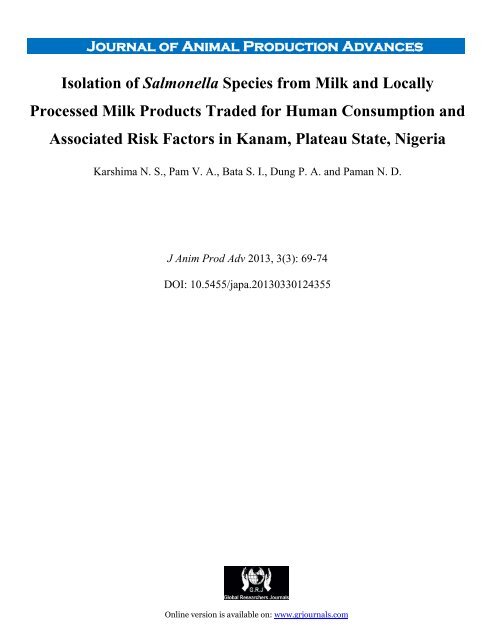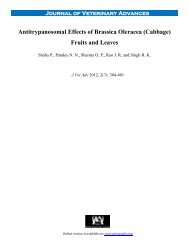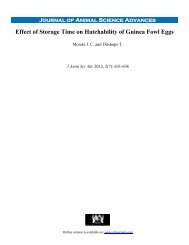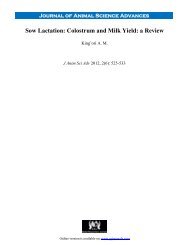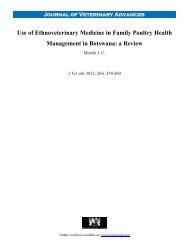Isolation of Salmonella Species from Milk and Locally ... - Grjournals
Isolation of Salmonella Species from Milk and Locally ... - Grjournals
Isolation of Salmonella Species from Milk and Locally ... - Grjournals
You also want an ePaper? Increase the reach of your titles
YUMPU automatically turns print PDFs into web optimized ePapers that Google loves.
Journal <strong>of</strong> Animal Production Advances<br />
<strong>Isolation</strong> <strong>of</strong> <strong>Salmonella</strong> <strong>Species</strong> <strong>from</strong> <strong>Milk</strong> <strong>and</strong> <strong>Locally</strong><br />
Processed <strong>Milk</strong> Products Traded for Human Consumption <strong>and</strong><br />
Associated Risk Factors in Kanam, Plateau State, Nigeria<br />
Karshima N. S., Pam V. A., Bata S. I., Dung P. A. <strong>and</strong> Paman N. D.<br />
J Anim Prod Adv 2013, 3(3): 69-74<br />
DOI: 10.5455/japa.20130330124355<br />
Online version is available on: www.grjournals.com
ISSN: 2251-7677<br />
KARSHIMA ET AL.<br />
Original Article<br />
<strong>Isolation</strong> <strong>of</strong> <strong>Salmonella</strong> <strong>Species</strong> <strong>from</strong> <strong>Milk</strong> <strong>and</strong><br />
<strong>Locally</strong> Processed <strong>Milk</strong> Products Traded For<br />
Human Consumption <strong>and</strong> Associated Risk Factors<br />
in Kanam, Plateau State, Nigeria<br />
1 Karshima N. S., 2 Pam V. A., 1 Bata S. I., 1 Dung P. A. <strong>and</strong> 1 Paman N. D.<br />
1 Department <strong>of</strong> Animal Health, Federal College <strong>of</strong> Animal Health <strong>and</strong> Production Technology Vom, Plateau State, Nigeria.<br />
2 Department <strong>of</strong> Parasitology, National Veterinary Research Institution Vom, Plateau State, Nigeria.<br />
Abstract<br />
This study was conducted to determine the prevalence <strong>of</strong> <strong>Salmonella</strong> species in milk <strong>and</strong> locally processed<br />
milk products traded for human consumption <strong>and</strong> assess the risk factors associated with <strong>Salmonella</strong> milk<br />
contamination in the study area. The study utilized microbiological culture <strong>and</strong> isolation as well as<br />
questionnaire analysis. A total <strong>of</strong> 600 samples were studied, 200 each for fresh milk (madara), full creamed<br />
milk (kindirmo) <strong>and</strong> skimmed milk (nono). The study revealed an overall prevalence <strong>of</strong> 8.7% (52/600). About<br />
0.2% (1/600), 3.0% (18/600), 1.0% (6/600), 2.0% (12/600) <strong>and</strong> 2.5% (15/600) <strong>of</strong> the overall prevalence were<br />
recorded in Dengi, Gargah, Kanam, Gagdi <strong>and</strong> Gidgid districts <strong>of</strong> the Local Government Area (LGA)<br />
respectively. This revealed a high level <strong>of</strong> statistical significance (P
ISOLATION OF SALMONELLA SPECIES FROM MILK AND LOCALLY …<br />
Introduction<br />
Generally, milk has been described as a nearly<br />
perfect food because it contains the essential<br />
nutrients required by the body in appropriate<br />
proportions. However, it is a very efficient vehicle<br />
for bringing a large number <strong>of</strong> people into contact<br />
with potential microbial hazards (Jordan, 2007).<br />
The safety <strong>of</strong> dairy products with respect to foodborne<br />
diseases is a major global issue especially in<br />
the developing countries where production <strong>of</strong> milk<br />
<strong>and</strong> milk product takes place under poor hygienic,<br />
sanitary <strong>and</strong> Agricultural practices (Jordan, 2007).<br />
Bacterial organisms which may gain entry into<br />
milk can multiply <strong>and</strong> cause spoilage, rendering raw<br />
or processed milk unsuitable for human<br />
consumption due to rancidity, musty odour, or toxin<br />
production (Nanu et al., 2007). These organisms in<br />
milk indicate inadequate milking procedures, poor<br />
storage conditions, or unhygienic productions (Gran<br />
et al., 2003; Girmaud et al., 2009). The presence <strong>of</strong><br />
pathogenic bacteria which may not be associated<br />
with spoilage <strong>of</strong> milk such as <strong>Salmonella</strong> spp,<br />
Brucella spp, Mycobacterium bovis, Listeria<br />
monocytogenes <strong>and</strong> Campylobacter jejuni can<br />
render raw <strong>and</strong> processed milk unsafe for human<br />
consumption (Nanu et al., 2007).<br />
Salmonellosis is the most common food-borne<br />
bacterial disease worldwide (Forshell <strong>and</strong> Wierup,<br />
2006). There have been increased outbreaks <strong>of</strong><br />
human salmonellosis in most parts <strong>of</strong> the world<br />
resulting <strong>from</strong> animal infections (Forshell <strong>and</strong><br />
Wierup, 2006). The prevention <strong>and</strong> control <strong>of</strong><br />
animal salmonellosis has become a global issue, as<br />
this has been established as the main source <strong>of</strong><br />
outbreaks in humans (EFSA, 2006).<br />
Food-borne salmonellosis has remained a<br />
neglected zoonosis in Nigeria <strong>and</strong> other developing<br />
countries <strong>of</strong> the world, despite an upsurge <strong>of</strong> cases<br />
reported. Raw milk <strong>and</strong> milk products are<br />
increasingly becoming important sources <strong>of</strong> human<br />
infection with <strong>Salmonella</strong>. Food vehicles implicated<br />
in most food-borne disease outbreaks is <strong>of</strong>ten<br />
consumed or discarded before clinical symptoms<br />
develop in the exposed individual (Fontaine et al.,<br />
1980). The screening <strong>of</strong> milk <strong>and</strong> other dairy<br />
products against pathogenic organisms will play a<br />
vital role in curtailing human infection. This study<br />
determined the prevalence <strong>and</strong> the risk factors<br />
associated with <strong>Salmonella</strong> contamination <strong>of</strong> milk<br />
<strong>and</strong> locally processed milk products in Kanam<br />
Local Government Area <strong>of</strong> Plateau State, Nigeria.<br />
Materials <strong>and</strong> Methods<br />
Study Area<br />
The study was conducted in Kanam Local<br />
Government Area <strong>of</strong> Plateau State, Nigeria. Kanam<br />
is located in the central zone <strong>of</strong> the state. The study<br />
covered five districts namely Dengi, Gargah,<br />
Kanam, Gagdi <strong>and</strong> Gidgid. The major occupation in<br />
this area is crop <strong>and</strong> livestock farming.<br />
Sample Collection<br />
A total <strong>of</strong> 600 milk samples were collected<br />
<strong>from</strong> five district <strong>of</strong> Kanam LGA <strong>of</strong> Plateau State,<br />
Nigeria. <strong>Milk</strong> samples were collected using<br />
systematic sampling technique. Using the sitting<br />
arrangement <strong>of</strong> milk sellers, the fifth milk sellers<br />
were sampled each day until 120 samples were<br />
collected <strong>from</strong> each <strong>of</strong> the five districts. A total <strong>of</strong><br />
100 ml <strong>of</strong> thoroughly mixed milk were purchased<br />
<strong>from</strong> milk sellers <strong>and</strong> transferred into sterilized,<br />
clean <strong>and</strong> dry sample bottles <strong>and</strong> transported in ice<br />
cool flash within 6 hours to the bacteriology<br />
laboratory <strong>of</strong> the National Veterinary Research<br />
Institute Vom, Nigeria for microbiological analysis.<br />
<strong>Isolation</strong> <strong>and</strong> Identification <strong>of</strong> <strong>Salmonella</strong><br />
spp.<br />
The isolation <strong>of</strong> <strong>Salmonella</strong> spp. was carried<br />
out using the method described by Quinn et al.<br />
(2002). The samples were enriched in Rapport-<br />
Vasilliadis broth. A sterile swab <strong>from</strong> raw or locally<br />
processed milk sample was inoculated into Rapport-<br />
Vasilliadis broth <strong>and</strong> incubated at 37 O C for 24<br />
hours. A loopful <strong>of</strong> Rapport-Vasilliadis broth was<br />
streaked onto xylose lysine desoxycholate agar <strong>and</strong><br />
incubated for a further 24 hours at 37 O C. The<br />
colonies were examined for the characteristic<br />
pinkish colour <strong>of</strong> <strong>Salmonella</strong> with or without<br />
hydrogen sulphite. Suspected colonies were then<br />
subjected to indole, motility, oxidase, urease, citrate<br />
<strong>and</strong> sugar fermentation tests for identification <strong>of</strong><br />
<strong>Salmonella</strong> spp.<br />
Results<br />
70 J. Anim. Prod. Adv., 2013, 3(3):69-74
KARSHIMA ET AL.<br />
A total <strong>of</strong> 600 samples were studied, 200 each<br />
for fresh milk (madara), full creamed milk<br />
(kindirmo) <strong>and</strong> skimmed milk (nono) as shown in<br />
Tables 1-3. The study revealed an overall<br />
prevalence <strong>of</strong> 8.7% (52/600) as shown in Tables 1-<br />
3. About 0.2% (1/600), 3.0% (18/600), 1.0%<br />
(6/600), 2.0% (12/600) <strong>and</strong> 2.5% (15/600) <strong>of</strong> the<br />
overall prevalence were recorded in Dengi, Gargah,<br />
Kanam, Gagdi <strong>and</strong> Gidgid districts <strong>of</strong> the Local<br />
Government Area (LGA). This revealed a high level<br />
<strong>of</strong> statistical significance (P
ISOLATION OF SALMONELLA SPECIES FROM MILK AND LOCALLY …<br />
Table 4: Analysis <strong>of</strong> risk factors associated with <strong>Salmonella</strong> contamination <strong>of</strong> milk traded for human consumption<br />
in Kanam LGA.<br />
Statistical significance<br />
Risk factor NQA R NR Prev (%)<br />
P Odd Ratio 95% CI<br />
Aware <strong>of</strong> salmonellosis 600 Yes 412 37 (8.89) 0.6858 1.1380 0.6082, 2.1290<br />
No 188 15 (8.89)<br />
Aware that <strong>Salmonella</strong> can be acquired<br />
through milk consumption<br />
600 Yes 107 12 (11.2) 0.3013 1.4305 0.7233, 2.8293<br />
No 493 40 (8.11)<br />
Suck milk directly <strong>from</strong> the udder 600 Yes 302 46 (15.2)
KARSHIMA ET AL.<br />
<strong>from</strong> their wool or defecation into the stream. For<br />
this reason stream water is believed to contain high<br />
levels <strong>of</strong> bacterial load. This is also the likely<br />
explanation for the higher prevalence recorded by<br />
milk samples processed using water <strong>from</strong> the<br />
stream. The lowest prevalence recorded by samples<br />
processed by borehole water may not be<br />
unconnected with the cleanliness <strong>of</strong> the water<br />
source used for milk processing.<br />
Risk factors associated with <strong>Salmonella</strong><br />
contamination <strong>of</strong> milk<br />
There were high associations between the<br />
prevalence <strong>of</strong> <strong>Salmonella</strong> in milk <strong>and</strong> milk products<br />
<strong>and</strong> sucking milk directly <strong>from</strong> the udder <strong>of</strong> cows<br />
(P


